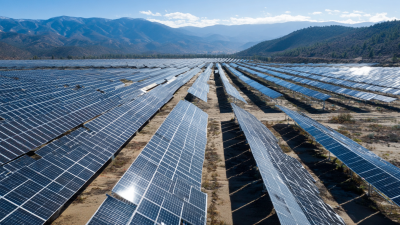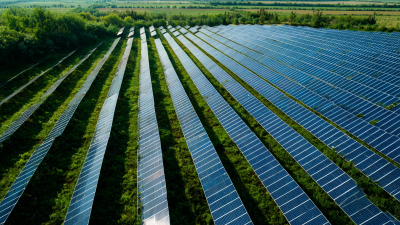
Blog
Exploring Innovative Sustainable Energy Solutions for a Greener Tomorrow
The urgent need for a transition to sustainable energy solutions has become increasingly evident in light of global climate change challenges and rising energy demands. According to the International Energy Agency's (IEA) World Energy Outlook, achieving net-zero emissions by 2050 requires a drastic overhaul of our energy systems, emphasizing a shift from fossil fuels to renewable sources. Innovative sustainable energy solutions not only address environmental concerns but also provide significant economic opportunities, supporting job creation and enhancing energy security.

By harnessing cutting-edge technologies and embracing integrated approaches, we can pave the way for a sustainable energy landscape that not only meets the demands of the present but also secures a healthier planet for future generations. This exploration of the top five innovative sustainable energy solutions underscores the potential to transform our energy systems into a resilient and environmentally friendly framework, crucial for a greener tomorrow.
Innovative Renewable Energy Technologies Transforming the Energy Landscape
The energy landscape is undergoing a transformative shift as innovative renewable energy technologies emerge to address the pressing challenges of climate change and sustainability. From solar panels that maximize efficiency through advanced materials to wind turbines designed for urban environments, these solutions promise to revolutionize how we harness natural resources. The integration of smart grids facilitates the efficient distribution of energy, ensuring that renewable sources are utilized optimally.
Tips: When considering renewable energy options for your home, evaluate your local climate and resources. For example, solar energy might be more advantageous in sunny regions, while wind power could be ideal in areas with consistent breezes. Additionally, look into government incentives that can help offset installation costs.
As we continue to innovate, new approaches such as energy storage systems are crucial for balancing supply and demand. Battery technologies are advancing, allowing households and businesses to store excess energy generated during the day for use at night. This not only enhances energy independence but also contributes to a more resilient energy system that can withstand fluctuations in supply.
Tips: Research various types of energy storage solutions available, comparing costs and performance to find what best suits your energy needs. Also, engage with community programs that promote shared renewable energy projects, benefiting both individual users and the environment.
The Role of Energy Storage in Enhancing Sustainability and Efficiency
Energy storage is becoming a pivotal factor in the global shift toward sustainable energy solutions. As renewable sources like solar and wind power are inherently intermittent, the ability to store excess energy is crucial for maintaining a stable supply. According to a report by the International Renewable Energy Agency (IRENA), energy storage capacities could reach 2,850 gigawatts (GW) by 2030, a significant increase that underscores the importance of innovative technologies in this sector.
Diversifying energy storage solutions involves various technologies such as lithium-ion batteries, pumped hydro storage, and emerging methods like flow batteries. The Bloomberg New Energy Finance report estimates that the battery storage market alone could surpass $250 billion by 2025 due to the demand for renewable energy integration and grid stability. This investment not only enhances grid resilience but also contributes to reducing carbon emissions by maximizing the utilization of clean energy sources. As we explore innovative approaches to energy storage, we are not only addressing efficiency and reliability but also paving the way for a greener tomorrow.
Exploring Innovative Sustainable Energy Solutions for a Greener Tomorrow
| Energy Solution | Description | Efficiency (%) | Sustainability Index (1-10) | Storage Solution | Capacity (kWh) |
|---|---|---|---|---|---|
| Solar Energy | Harnessing sunlight using photovoltaic cells. | 20 | 9 | Lithium-ion Battery | 10 |
| Wind Energy | Utilizing wind turbines to generate electricity. | 45 | 8 | Flow Battery | 100 |
| Hydroelectric Power | Generating electricity by harnessing water flow. | 35 | 9 | Pumped Storage | 200 |
| Biomass Energy | Using organic materials to produce energy. | 25 | 7 | Compressed Air Storage | 50 |
| Geothermal Energy | Utilizing heat from the Earth's core. | 10 | 8 | Thermal Storage | 15 |
Integrating Smart Grids for Optimized Energy Management
The integration of smart grids into sustainable energy solutions is a pivotal development for optimizing energy management and addressing the global shift towards greener practices. Smart grids facilitate the incorporation of advanced technologies, such as energy management systems and AI data analysis, to effectively monitor and distribute energy resources. Recent projections indicate that the global smart grid market is expected to reach approximately $49.45 billion by 2023, with a compounded annual growth rate of 13.45% from 2024 to 2031. This growth underscores the increasing demand for innovative platforms that enhance energy efficiency and reduce operational costs.
Tips for implementing smart grid technology effectively include investing in comprehensive energy management systems that harness big data analytics to optimize resource allocation. Companies should focus on integrating AI-driven insights to forecast energy usage patterns and improve decision-making processes. Collaborating with technology providers can also enhance the adaptability and scalability of smart grid implementations, ensuring that organizations are well-prepared for future energy challenges.
Moreover, as the landscape of energy management evolves, organizations that embrace digital energy solutions will be at the forefront of the transition towards low-carbon economies. The global market for digital energy consulting is projected to grow from $1.08 billion in 2025 to $1.91 billion by 2034, reflecting a compound annual growth rate of 6.5%. Engaging with these innovative approaches not only streamlines operations but also positions businesses as leaders in the sustainability movement.
Exploring Policy Frameworks for Promoting Sustainable Energy Solutions
As we explore innovative sustainable energy solutions, understanding the policy frameworks that promote these initiatives is crucial. Governments play a pivotal role in shaping the future of energy through regulations, incentives, and funding. By creating supportive policies, they can encourage investments in renewable energy technologies, enhance research and development, and facilitate the transition to a low-carbon economy. A collaborative approach involving stakeholders—from policymakers to local communities—ensures that the frameworks not only promote sustainable practices but also consider economic viability and social equity.
Tips for navigating these policies include staying informed about local and national regulations that impact energy use. Engaging with local government initiatives can provide opportunities for community input, ensuring that sustainable energy solutions are tailored to the specific needs of the population. Additionally, businesses can benefit from understanding tax incentives and grants aimed at supporting clean energy projects, which can significantly offset initial costs and accelerate adoption.
In promoting sustainable energy solutions, it is essential to foster public awareness and education. By encouraging community participation in energy audits and sustainability workshops, individuals can become more conscious of their energy consumption and its effects on the environment. This grassroots level of engagement contributes to a more robust policy framework, as informed citizens can advocate more effectively for sustainable practices and hold their governments accountable.
Community-Centric Approaches to Implementing Green Energy Initiatives
As communities across the globe seek to mitigate the impacts of climate change, community-centric approaches to implementing green energy initiatives have emerged as a promising strategy. According to a report by the International Renewable Energy Agency (IRENA), local renewable energy projects not only reduce carbon emissions but also foster economic growth and job creation. The report indicates that transitioning to renewable energy sources can generate up to 24 million jobs worldwide by 2030, emphasizing the critical role that community involvement plays in harnessing this potential.
Participatory engagement is key in these initiatives, as communities are more likely to support and sustain energy projects that align with their needs and values. A study from the Rocky Mountain Institute found that community-led renewable energy projects have a 50% higher success rate compared to those without local engagement. These projects empower residents, increase energy literacy, and build local resilience, ultimately leading to a more sustainable energy future. By prioritizing inclusivity and collaboration, communities can effectively drive the adoption of innovative sustainable energy solutions that pave the way for a greener tomorrow.
Renewable Energy Adoption in Communities (2023)
This chart illustrates the community adoption rates of various renewable energy sources in 2023. Solar energy leads the way with 35%, emphasizing the growing trend towards sustainable solutions for a greener future.
Related Posts
-

Comparing Top Green Energy Solutions for Sustainable Business Practices
-

Navigating the Future of Best Sustainable Energy Solutions in 2025 with Practical How to Strategies
-

Top Green Solar Power Solutions for Ultimate Energy Efficiency Comparison
-

Innovative Green Energy Alternatives Shaping the Future of 2025 Technology Trends
-

Top Strategies for Sourcing the Best Green Energy Solutions in a Competitive Market
-

Understanding the Importance of Solar Green Technology in Sustainable Energy Solutions